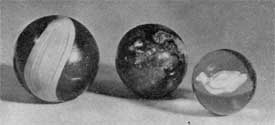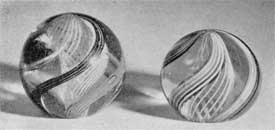MARBLES
The Marble might have originated in Pakistan near the river Indus. Various marbles of stone were found on excavation there. Marbles are also often mentioned in Roman literature, and there are many examples of marbles from ancient Egypt. They were commonly made of clay, stone or glass. Clay balls have also been found in Native American burial grounds and ancient Aztec pyramids.
They seem to have been popular at the time of Emperor Augustus in the century before the beginning of the Christian era and there are frequent allusions in the records of the Romans to the use of marbles in games of sport.
It may have been by these people that the knowledge of marbles was spread across the European continent and into England for after the final conquest of Britain by the Romans in the latter part of the first century A.D., it is recorded that marbles made from stone were used by children as well as grown people in their play and games. We are led to conclude that in England they received an early appreciation and as their use increased they were better made and formed from real marble as well as stone and also from dried or baked clay.
Later on pottery, alabaster, and agate were employed in their making. Glass marbles, so far as records show, had their origin with the old glass makers of Venice. These were called “monstrosities” by the English who looked upon them as trifling playthings and not serviceable in their games.
During the 17th and 18th Centuries the making of these glass marbles became an industry of the Germans who by the skillful use of bright colors and ornamental figures made them attractive as toys. Their production centered in and about the quaint old city of Nuremberg which for many years held full prestige over any other in the world in the production of these winning little playthings. Many of the best stone and alabaster marbles were likewise produced in Germany; the province of Saxony for the most part supplying them.
As time went on the games of marbles in England towered to such a height in popularity that for a long period they overshadowed other sports. They furnished amusement for children, competitive rivalry in sports among the students of the universities, and were a pastime of almost universal choice with the elders.
In the earlier period much of the playing was done with but two sorts of marbles; the ally-tors, made from real marble, and commoneys, made from clay or a plaster composition. The ally-tors were considered more valuable than the commoneys and one of the former might be exchanged for six of the latter.
It is presumed that the ally-tor marbles got their name from the word tor which is Celtic for rock or stone. Taw was the name given to an ally-tor marble used for shooting the others in the game of ring taw.
A white alley was an ally-tor made of white marble. A taw with a reputation of being lucky in its winnings was much coveted. Commoneys were unglazed while polleys were the same as commoneys but glazed.
Alleys were made from actual stone or marble chips obtained from the quarries; stonies were made from pebbles or a hard composition like stone and painted in some solid color. Blood alleys were of marble and so named because of the red spots in the material from which they were made. They were considered especially lucky. Later ally-tors were made of alabaster. Bounces were large marbles, made of stone. Their size and weight prevented their adaptation, to any great extent, in the games of marbles.
Marbles of crockery were called crookeys. They were slightly glazed and usually colored brown or yellow, one color being on one side and the other color on the opposite side. Some were made of red brick-clay and for the most part unpainted. They were called clayes.

Three Marbles of Early American Make: At the left, one of opaque black glass with surface decoration. In the center a mottled pottery marble in colorings like the Bennington ware which copied that made at the Rockingham pottery. At the right an excellent example of a clear glass marble with silver-like sulphide center in the shape of a water fowl.
Marbles made of white marble were sometimes called marble marbles. China alleys were made of china ware with white glaze and rings of different colors painted on them and were called chineys. Marbles made from chips of stone, marble, alabaster, quartz and carnelian were often called shooters.
The carnelians were a valued possession as also were the flints and moon agates, made from quartz and agate. The term ringer was sometimes used to mean the same as commoners.
An early game in England was that of Bowls. This was played with balls weighted on one side which was for the purpose of hobbling their speed or changing their course of direction. Marbles were at times used as substitutes for these balls and finally superseded them.

Antique Swirled Glass Marbles: With these the bases were flattened so that they became miniature paperweights.
Another game played with marbles in England known as Boss or Boss and Span or Boss Out consisted of bowling a marble to some distance and then this marble was used as a mark at which the opposing player could bowl his marble with the attempt to hit the first or to bring his near enough to span the space between the two with another one and so touch both of them. If he succeeded he won the game, but if he failed his marble became a mark for the first player to attempt to win in the same way, this alternating turn from one to the other going on until the game ended. Something after the order of billiards was the English game of Span Counter and marbles were often substituted, especially where counters were lacking.
From the Encyclopedia Britannica
Marble is defined as a small, hard ball that is used in a variety of children’s games and is named after the 18th-century practice of making the toy from marble chips. Marble games date from antiquity, and ancient games were played with sea-rounded pebbles, nuts, or fruit pits. The young Octavian (later the emperor Augustus), like other Roman children, played games with nut marbles, and engraved marbles have been dug up from the earthen mounds built by some early North American Indian tribes. Jewish children use filberts as marbles at Passover.
In the 20th century, marbles have been made of a variety of materials: baked clay, glass, steel, plastic, onyx, agate. Particular marbles may be known for their use (shooters may be called taws, a word of obscure origin); their original material (alleys were once made of alabaster); or their appearance (e.g., “flints,” “cloudies”).
The object of marble games is to roll, throw, drop, or knuckle marbles against an opponent’s marbles, often to knock them out of a prescribed area and so win them. (Knuckling is the act of placing a marble on the forefinger, balancing that finger or the bottom of the hand against the ground, and shooting the marble outward with the thumb.)
The names and rules of marble games are as varied as the localities and countries where they are played, but a few may be mentioned. In taw, ringtaw, or ringer, players attempt to shoot marbles, sometimes arranged in a cross, out of a ring as much as 6 to 10 feet (about 2 to 3 m) in diameter. In hit and span, players try to shoot or roll marbles either against an opponent’s marbles or a hand’s span from them. In various pot games (a pot is a small hole in the ground), including moshie, the player tries to pitch his own marbles or knock his opponents’ marbles into a hole. In bridgeboard, or nineholes, a board with several numbered arches is set up, and players try to shoot their marbles through the arches. A Chinese marble game consists of kicking a marble against an opponent’s to make the latter rebound in a specified direction. Local, regional, and national tournaments are held in many countries.
Game Rules
There are several different games which can be played with marbles, which are described below:
Ringer – using chalk or string draw a circle 10 feet (or 3 meters) across. Place 13 marbles in the center of the circle leaving 3 inches between each marble. Players must take turns shooting from outside the ring trying to knock the marbles in the middle out of the circle. The first player to knock out 7 marbles wins!
Tic Tac Toe – Draw tic-tac-toe squares on the ground with chalk or in the dirt and take turns shooting from 3 feet away. The first one to line up their marbles three in a row wins. Of course if you knock the other player out of the square you need to win, that just adds to the fun!
Boxies – Set a shoe box or other box on its side with the opening toward you. From 3 feet away take turns attempting to shoot you marble into the box. The first player to get his marble into the box wins!
Lagging – Draw a line on the ground, or you can play against a wall. Players take turns tossing their marble from 3 feet away to ward the line or wall. The object is to get your marble as close to the line or wall as possible with out going over it or hitting the wall. The player closest to the wall or line wins!
Keeps – Each player contributes 5 – 10 marbles from his own collection to any of the above games. The winner gets to keep all the marbles from the play when the game ends.
References:
1. Baumann, Paul; Antiques & Collectibles, Krause Publications Incorporated, 1999.
2. Watson, Dr. Henry W.; American Collector magazine, July 1943.
